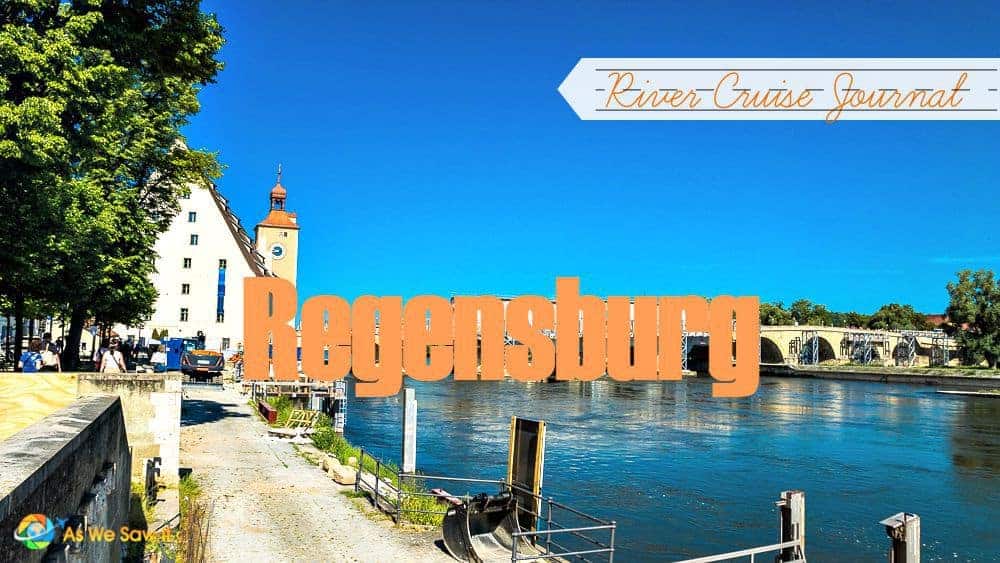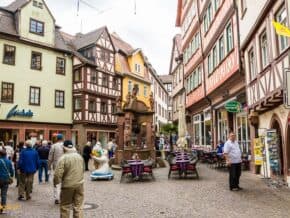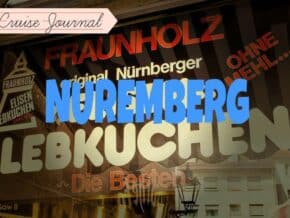If you think you need weeks to explore Europe's hidden gems, think again. Our Viking river cruise gave us just one day in Regensburg, but it was enough to fall in love with this often-overlooked Bavarian treasure.
As I soaked in the sights, I couldn’t help but marvel at how much history is packed into this charming town. Regensburg offers a delightful mix of medieval charm and modern vibrancy, making it an ideal spot for anyone looking to experience the heart of Bavaria. Curious about what you can see and do in just one day? Read on!

How to tour Regensburg
As we leisurely enjoyed breakfast aboard the Bragi, we considered our options for the day ahead. With tours set to begin at 9:30 AM, there was no need to rush off the ship—after all, it’s not like Regensburg was going anywhere! Viking offered three intriguing choices: a walking tour of Regensburg, a Jewish heritage tour, and a church architecture walk.
After some deliberation, Dan decided on the Jewish heritage tour. Perhaps it was the extra thirty minutes it promised, or our preference for smaller groups that swayed him. Plus, I think he was secretly hoping for fewer chances to hear about Gothic arches.
Regensburg is both the oldest city on the Danube River and one of the best preserved medieval towns in Europe. In fact, it is so well-preserved that the Old Town of Regensburg and Stadtamhof is a World Heritage Site, “an exceptional example of a central-European medieval trading centre.”
With all that history packed into one place, I was ready to dive into its stories—steeples and all!
Starting our Regensburg tour
Our guide, Sylvia Seifert, was a local gem, full of knowledge about Regensburg's Jewish history. She promised to show us the city's highlights while weaving in its Jewish past. As it turns out, you can't really separate the two in Regensburg.
Back in the Middle Ages, Regensburg had a pretty big Jewish community that played a key role in the city's life. Sylvia told us that Regensburg has always been a melting pot of cultures, thanks to its position as a trading hub. The oldest signs of Jewish life here go way back to medieval times, when the city was a hotspot for Jewish learning.
Sylvia explained that until 1519, when the Jews were forced out, most of them lived near the main crossroads in the heart of the city. This made sense given their main job: lending money. But here's the kicker—they didn't choose this career path. It was more like they were pushed into it.
The Church had told Christians they couldn't lend money, and Jews weren't allowed to join the local trade groups. So, without many other choices, they became the go-to moneylenders in town. Sylvia pointed out that this is where the whole “Jews and money” stereotype got its start.
I love discovering little nuggets like these. It makes travel all that much more fun!
The stone bridge

Our walk to town began along the riverfront with a beautiful view of the city’s pride and joy: a historic stone bridge that was built in the 12th century. It was the only bridge across the river for more than 800 years, until another was built In the 1930s.
With its 16 stone arches, she said, it was an incredible piece of construction for that time period. It has seen a lot of traffic over the centuries and was doing fine until engineers determined that all the cars, trucks and buses were stressing the structure too much. So now it’s just a pedestrian bridge.
At the far end of the stone bridge is Stadtamhof, an old town that has since been absorbed into Regensburg. It’s part of UNESCO's heritage site area. I made a mental note to see it during our free time but got so engrossed in seeing the rest of Regensburg that I forgot to.
Historiche Wurstkuche

As we approached the bridge, we came to an ancient building called Historiche Wurstkuche. It is a 12th-century tavern and sausage kitchen – the oldest sausage kitchen in Europe – and still furnishes tourists and locals with beer and traditional sausages. I wonder how many sausages they have served and how many barrels of beer they have rolled through their doors over all that time.
Roman walls and gate

Although Regensburg is known as a well-preserved medieval city, it has actually been around since Roman times. Remnants of the original city wall and a gate are still standing. Still.
Yes, most of the city’s medieval center was spared from damage during World War II. The ancient bridge, on the other hand, was not as fortunate: As the Nazis retreated at the end of the war, they blew up a part of the historic bridge to deter the Allies. I’m glad they were able to repair it.

Altes Rathaus (old city hall)

The Old Town Hall (Altes Rathaus) dates from the 14th century and has a remarkably large medieval courtroom. We arrived just as a wedding party was leaving the building. Germany does not recognize church weddings so people who wish to get married must make it a legal union at the city hall. If they wish to formalize it before God with a religious ceremony, they do that the next day.
Dom St. Peter (Regensburg's cathedral)
Regensburg's cathedral is a landmark in the city. Built in the 1300s it is one of the best examples of Gothic architecture in Bavaria. No doubt, it was on that church architecture tour!

Oskar Schindler’s former home

One of the reasons we like to take walking tours in Germany is that they allow us to discover hidden historical sites, like Oskar Schindler’s former home. Because there is only a simple plaque indicating its location, we probably would have missed it if we had been exploring on our own. Schindler lived here with his wife, Emilie, from May 1945 until September 1946, shortly after World War II ended.
Most people know him as the man who saved over a thousand Jewish lives during the Holocaust, thanks in part to the film Schindler’s List. What many don’t realize is that he spent time in Regensburg trying to rebuild his life after the war. Schindler had spent his entire fortune on bribes and black-market purchases to protect his workers during the war, leaving him nearly penniless and in need of a fresh start.
While this building may not stand out among Regensburg's many historical sites, it holds significant meaning. It’s a bit ironic that such an impactful figure is commemorated with just a small sign—perhaps a nod to how true heroism often goes unnoticed in everyday life.
If you’re looking for things to do in Regensburg, don’t miss this spot. Located at Watmarkt 5, it’s a brief yet oignant stop that adds depth to your understanding of the city’s history. Which just goes to show how even the most unassuming places can hold remarkable stories!
Neupfarrplatz: A Surprising Discovery
In 1995, the city of Regensburg decided to dig up Neupfarrplatz to install electrical outlets for the Christmas Market. You’d think they’d have learned from 2,000 years of history that digging in an ancient city might lead to unexpected surprises.
As luck would have it, they uncovered well-preserved ruins of a first-century Roman military camp and the medieval Jewish Quarter. What was supposed to be a simple project turned into a three-year archaeological dig.
It’s a classic case of “be careful what you wish for”—who knew that trying to set up some holiday cheer would lead to such significant historical finds? Next time, maybe they’ll just stick to string lights!
Site of the ancient synagogue

The Jewish Quarter had been torn down and torched after the town council expelled the Jews in 1519. As a tribute to that event, the city decided to build a memorial to the Jews. The beloved synagogue has been memorialized with a sculpture that artistically reproduces the layout of the original building … on its original foundation.
The Israeli artist Dani Karavan envisioned a gathering place for people of all beliefs, with plenty of spots to reflect, or relax and enjoy an ice cream or simply people watch. He entitled his sculpture Place for Thought. Now, where the Torah ark once stood, Hebrew characters now spell out the word “Misrach” (“place of lighting up”).
Stolpersteine
Then Sylvia invited us to follow her to a nearby corner so we could see an even more meaningful project: Stolpersteine (stumbling stones). These are small 10 cm-by-10 cm brass cobblestones in the sidewalks around the city that commemorate victims of National Socialism (Nazism).
Each one is inscribed with the name of a person — Jewish, Roma, homosexual, disabled, etc. — who had his or her last address at that spot. Keep your eyes open as you travel, you will find these tributes all over Europe.
Inside Dom St. Peter

Our tour ended at Dom St Peter. Rather than return to the boat for lunch, we decided to eat in town so we could save our feet for more exploring. After enjoying salads and espressos at a nearby Italian restaurant, we returned to the Dom to see what it looked like inside.


We had a lot of fun walking through Regensburg's winding old town streets and enjoyed the architecture as usual. We were surprised to find a Golf Museum – it seemed rather random. I was especially impressed with the wide collection of antiques and the variety of collectibles, including some exquisite chess sets.
Before you leave, be sure to stop at the bridge to visit the UNESCO center and museum. Then, climb to the top of the clock tower for some beautiful views.

Bye-bye, Danube!
As we left Regensburg and set sail our cruise director Devi offered a presentation on the Main-Danube Canal, the next leg of our journey. Soon the Bragi would carry us across the continental divide of Europe and water would begin to flow toward the North Sea.
We spent the evening chatting with shipmates and dancing in the lounge.
Next stop: Nuremberg.
Click here to see more photos from our day in Regensburg, Germany.




These posts are really changing the way I think about cruise travel. What an amazing and informative tour!
You’re right, Kacy. River cruises are a completely different experience from what we have experienced on mega-sized ocean liners. We really enjoyed the intimate experience and made some good friends. It was so nice having Viking there to plan everything; all we had to do was relax!
Now we want to try a river cruise in Asia. Their itineraries are amazing!